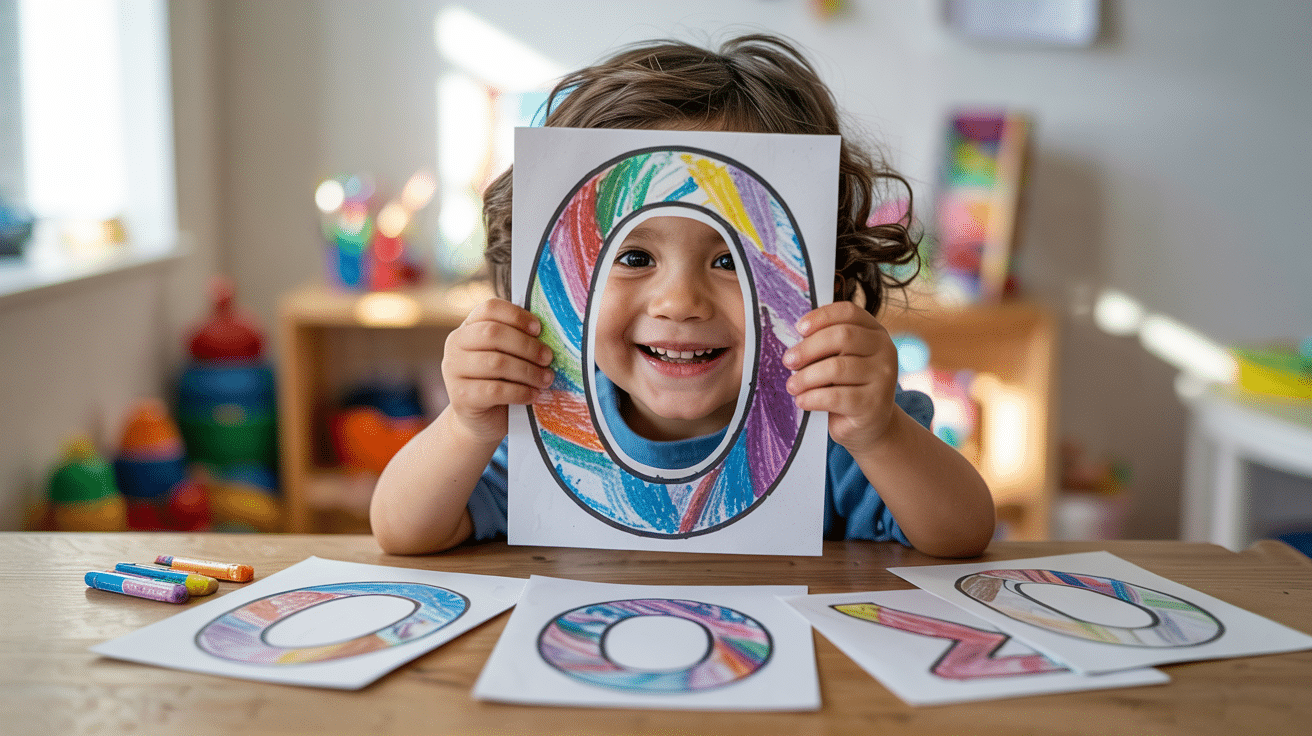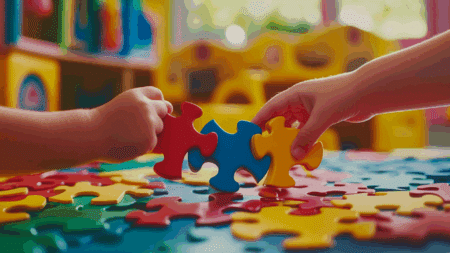Kids struggle with letters. Parents often find themselves at a loss when teaching children the alphabet.
The confusion between ‘b’ and ‘d’, the mix-up of similar-looking letters, and the lack of interest in learning can make the process tough for both child and parent.
But teaching letters doesn’t have to be boring! With fun, hands-on activities that turn learning into play, children can master the alphabet without even realizing they’re studying.
These methods work because they engage multiple senses and create happy memories linked to each letter.
Ready to make letter learning fun? These letter identification activities will help your child recognize letters quickly and build a solid foundation for reading.
The Role of Letter Recognition in Early Learning

Letter recognition is a child’s ability to spot, name, and know letters by their shapes and sounds. It’s one of the first steps toward reading. When a child sees “A” and can say “ay,” they’re showing letter recognition skills.
This includes knowing both uppercase and lowercase forms.
This skill matters because it builds the base for reading and writing. Kids who can tell letters apart find it easier to form words later. They also connect letter sounds to make up words, which helps with spelling.
Studies show that children who learn letters early often read better in school. Parents can help by pointing out letters in daily life – on food boxes, street signs, or books. Simple games can make this learning fun and easy.
How Letter Identification Activities Support Learning?
Letter identification activities help kids learn through play. They turn what could be dull drills into fun games that stick in memory. When a child touches sand letters, builds with blocks, or hunts for hidden letters, they use many senses at once.
These activities work with different learning styles. Visual learners enjoy colorful letter cards. Children who learn by doing prefer hands-on games like fishing for letters.
Those who learn by hearing benefit from songs and rhymes about the alphabet. Regular practice with these activities builds brain connections for reading.
Children gain confidence as they master each letter. The play aspect keeps them engaged longer than formal lessons would. This mix of fun and learning creates a positive link to reading that lasts for years.
Best Letter Identification Activities to Boost Letter Recognition

Ready to turn letter learning into a fun experience? These hands-on activities make alphabet practice exciting for kids. Each one offers a different way to help little ones connect with letters through play, movement, and creativity:
1. Alphabet Hopscotch
Create a hopscotch grid with letters instead of numbers. Kids will jump to the correct letter when called out.
You can make it more challenging by asking them to hop to a specific letter or sequence of letters. It helps kids recognize letters and improve their coordination while having fun.
- Age Range: 3–5 years
- Skill Level: Beginner
- Learning Benefits: Letter recognition, gross motor skills, coordination
2. Letter Matching with Objects
Pair everyday objects around the house with corresponding letters (e.g., an apple for “A”, a ball for “B”). Ask the kids to match the objects with the letters. This hands-on activity helps kids make connections between letters and the real world.
- Age Range: 3–5 years
- Skill Level: Beginner
- Learning Benefits: Letter recognition, vocabulary expansion, visual discrimination
3. Alphabet Puzzle Race
Create an alphabet puzzle and mix up the pieces. Challenge the kids to race against time to put the puzzle together correctly. This activity reinforces letter shapes and recognition while fostering problem-solving skills.
- Age Range: 3–6 years
- Skill Level: Beginner
- Learning Benefits: Problem-solving, letter recognition, fine motor skills
4. Flashcard Fun
Use flashcards with letters on them and ask kids to identify the letter. You can also ask them to think of words that start with that letter. This quick activity builds speed and accuracy in letter identification.
- Age Range: 3–5 years
- Skill Level: Beginner
- Learning Benefits: Letter recognition, memory, language development
5. Magnetic Letter Search
Hide magnetic letters around the room and have kids find them. Once they collect the letters, they can match them to a chart or their own letter board. This interactive search engages kids in learning through movement.
- Age Range: 3–6 years
- Skill Level: Beginner
- Learning Benefits: Letter recognition, problem-solving, hand-eye coordination
6. Letter Painting
Give children large letter templates and allow them to paint or color them. You can add texture or decoration to make it more engaging. As they work, kids will reinforce letter shapes and sounds.
- Age Range: 3–5 years
- Skill Level: Beginner
- Learning Benefits: Letter recognition, creativity, fine motor skills
7. Letter Sorting Game
Prepare a set of letter cutouts and ask the kids to sort them into vowels and consonants. You can also use this activity to introduce letter sounds. Sorting letters helps kids better understand the alphabet.
- Age Range: 4–6 years
- Skill Level: Intermediate
- Learning Benefits: Letter recognition, categorization, phonics
8. Interactive Letter Songs
Teach a fun song that includes actions for each letter of the alphabet. For example, “A is for apple, B is for ball” with corresponding hand movements. This activity makes learning enjoyable through music and motion.
- Age Range: 3–5 years
- Skill Level: Beginner
- Learning Benefits: Letter recognition, memory, auditory processing
9. Letter Tracing in Sand
Fill a tray with sand and have children trace letters with their fingers. This tactile experience helps reinforce the shape and structure of letters while developing sensory skills.
- Age Range: 3–6 years
- Skill Level: Beginner
- Learning Benefits: Letter recognition, fine motor skills, sensory development
10. Letter Scavenger Hunt
Hide objects starting with different letters around the room. Have kids search for and identify the items by their first letter. This game encourages both active play and letter recognition.
- Age Range: 4–6 years
- Skill Level: Intermediate
- Learning Benefits: Letter recognition, problem-solving, vocabulary
11. Alphabet Bean Bag Toss
Write letters on bean bags and place corresponding baskets around the room. Ask kids to toss the bean bags into the right basket. This activity helps kids associate letters with their shapes and sounds.
- Age Range: 3–5 years
- Skill Level: Beginner
- Learning Benefits: Letter recognition, coordination, gross motor skills
12. Play-Dough Letters
Give children some play-dough and ask them to form letters. This hands-on approach reinforces letter shapes while enhancing fine motor skills and creativity.
- Age Range: 3–5 years
- Skill Level: Beginner
- Learning Benefits: Letter recognition, creativity, fine motor skills
13. Letter Flashlight Hunt
Place letter cards around the room and use a flashlight to shine on a card. Ask the child to identify the letter that the flashlight lands on. This activity engages children through visual and auditory learning.
- Age Range: 3–5 years
- Skill Level: Beginner
- Learning Benefits: Letter recognition, attention skills, sensory development
14. Bubble Wrap Letter Pops
Write letters on a sheet of bubble wrap. As children identify the letters, they get to pop the corresponding bubbles. This fun activity combines letter recognition with sensory play.
- Age Range: 3–5 years
- Skill Level: Beginner
- Learning Benefits: Letter recognition, sensory development, fine motor skills
15. Alphabet Obstacle Course
Set up an obstacle course with different stations where children must identify a letter before they can proceed. This active activity reinforces letter recognition and encourages physical movement.
- Age Range: 4–6 years
- Skill Level: Intermediate
- Learning Benefits: Letter recognition, gross motor skills, coordination
16. Letter Fishing Game
Create a fishing game with paper fish labeled with letters. Kids can “fish” with a magnetic rod and identify the letters they catch. This game builds letter recognition and motor skills.
- Age Range: 3–5 years
- Skill Level: Beginner
- Learning Benefits: Letter recognition, hand-eye coordination, fine motor skills
17. Storybook Letter Search
Pick a favorite storybook and ask kids to find letters as they come across them in the text. This activity helps kids associate letters with words and sounds.
- Age Range: 4–6 years
- Skill Level: Intermediate
- Learning Benefits: Letter recognition, reading skills, comprehension
Tips to Make Learning Playful and Fun

Making letter learning enjoyable helps kids stay interested and learn faster. Here are some simple ways to keep children engaged:
- Mix it up with colors and textures. Use bright markers, fuzzy felt, or shiny stickers to make letters stand out.
- Keep sessions short. Young children have limited focus, so aim for 5-15 minutes of letter practice at a time.
- Follow your child’s lead. If they show interest in certain letters (like those in their name), start there.
- Add movement to learning. Hop to alphabet squares or trace letters in the air with full arm motions.
- Connect letters to things they love. A child who likes trains might enjoy an alphabet train or “T is for train” activities.
- Be consistent but flexible. Daily practice helps, but switch activities when boredom starts.
- Give specific praise. Instead of just “good job,” try “You found all the letter Bs so quickly!”
- Make it social. Take turns, play together, and celebrate small wins as a team.
Final Thoughts
Letter recognition forms the building blocks of reading skills. The letter identification activities we’ve shared offer various ways to help children connect with the alphabet through play and creativity.
Remember that each child learns at their own pace. Some may quickly identify all 26 letters, while others need more time with each one. The key is keeping the process light and fun.
By mixing these activities into daily routines, you’ll help your child build confidence with letters. This early success often leads to a love of reading that lasts well beyond childhood.
Have you tried any letter activities that worked well with your child? Share your experiences in the comments below! We’d love to hear which games became favorites in your home.




